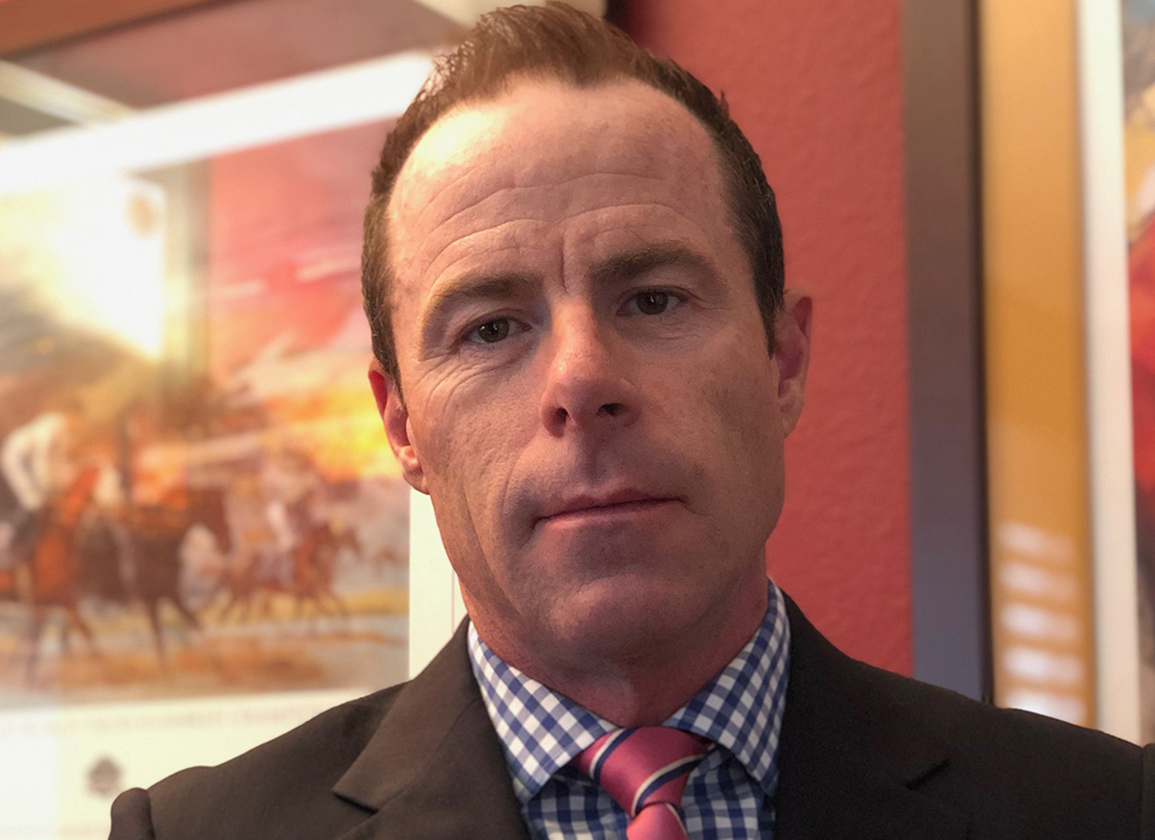The ongoing stand-off between California's Veterinary Medical Board (VMB) and the California Horse Racing Board (CHRB) has amounted to a regulatory turf war over California's backstretch veterinarians.
So far, the state's VMB has flexed its primacy, issuing dozens of records requests and, in a number of instances, complaints against vets within this colony. The highest profile such case concerned a settlement last year with CHRB equine medical director, Jeff Blea.
In that settlement, the VMB issued Blea a fine of more than $130,000, required him to undergo continuing education classes and placed him on probation–this, for issues that a consensus of prominent equine veterinarians said amounted largely to relatively minor record keeping violations, those typically resulting in just fines.
At the crux of the interagency dispute is this question: To whose set of rules should California's racetrack vets adhere? The VMB's rules built around the California Veterinary Medicine Practice Act, or the CHRB's own set of regulations?
This is a crucial question for the vets with complaints issued against them as the VMB is often seeking punitive actions for veterinary practices that are permitted under the CHRB's rule book.
This means that if a veterinarian settles their case with the VMB and returns to work under a probation order, they face potentially serious consequences–the loss of a license even–for breaching the VMB's standards of equine care, all the while abiding by the CHRB's rule of law.
But given federal preemption of state law, does the advent of the Horseracing Integrity and Safety Act's (HISA) anti-doping and medication control program (ADMC)–now set for launch later this month–change the dynamic of this regulatory impasse by becoming the ultimate arbiter of backstretch veterinary practice?
The answer is not altogether clear.
According to wording of the act, “HISA rules preempt State laws or regulations with respect to matters within the jurisdiction of HISA,” wrote Monica Vargas, a spokesperson for the Department of Consumer Affairs, which oversees the VMB.
In other words, HISA preempts state law only to the rules written into its books. The HISA Authority–the broad non-profit umbrella established by the act–takes a similar stance.
“The Act states that HISA rules preempt state law and regulations on the particular matters that the HISA rules address. In other words, if no HISA rule has been promulgated on a particular matter, a State is free to continue regulating it,” wrote a HISA spokesperson.
According to CHRB executive director, Scott Chaney, the broader matter of racetrack veterinary oversight is therefore far from resolved, with the advent of HISA meaning that California's backstretch vets are now essentially subject to three main regulatory bodies–the CHRB's rules still applying when neither HISA nor the VMB's rules are applicable.
“To me, this is the worst of all worlds–some areas preempted by HISA and other areas not,” said Chaney.
Craig Robertson, outside counsel for the American Association of Equine Practitioners (AAEP), also views the issue through muddy legal waters.
“If HISA speaks on a subject, it's intended to be pre-emptive. But you're likely to get into arguments about whether a specific subject is one that HISA speaks on and then preempts or not,” Robertson said. “I just don't think it is going to be black and white.”
As such, Robertson said that he is gearing up for a slew of lawsuits around the country, seeking to define who has ultimate jurisdiction over what when it comes to backstretch veterinary practice.
“There's enough grey area and nuance that I think it's going to make for creative lawyering for people like me to be able to argue various sides of these particular issues,” Robertson added.
Among some of the areas of conflict between the VMB and the CHRB that HISA appears to have resolved concerns drug administration.
This includes the use of what the VMB terms “dangerous drugs”–like the ubiquitously administered sedative acepromazine–and the use of non-FDA approved compounded medications like dantrolene, used on horses that tie-up.
Though the use of compounded medications are a standard practice in veterinary medicine, the CHRB's own Rule 1867 (b) has long stated that “the possession and/or use on the premises of a facility under the jurisdiction of the Board of any drug, substance or medication that has not been approved by the United States Food and Drug Administration (FDA) for use in the United States.”
The medical board has interpreted that rule categorically, detailing in complaints how no compounded drugs are FDA approved for use on CHRB licensed grounds, even if compounded from FDA approved parent drugs.
This prompted a recent CHRB emergency rule modification changing the language of the rule to permit awfully prescribed, compounded medications manufactured to federal and state guidelines.
Furthermore, the Horseracing Integrity and Welfare Unit–the arm of HISA charged with rolling out its ADMC program–has issued its lists of controlled and banned substances, making clear which drugs are permitted for use in covered horses and when. HIWU's controlled substances list includes medications like dantrolene and acepromazine.
“HISA obviously talks about medications and the treatment of horses,” confirmed Robertson.
HISA also has a provision that says, “the administration of medications and treatment methods to covered horses should be based upon an examination and diagnosis,” Robertson added.
This leads onto another backbone of the VMB's complaints against California's backstretch veterinary community: Alleged problems with their record keeping and with their veterinarian-client-patient relationships (VCPR), which covers a vet's familiarity with an animal before diagnosing and treating a medical condition.
According to the VMB, multiple California veterinarians have allegedly failed to establish an appropriate VCPR before administering, prescribing, dispensing, or furnishing medications and other medical treatments to the horses in their care.
In this regard, several equine veterinary experts have argued that the VMB has misconstrued the basic nature of backstretch veterinary practice, mistakenly substituting common standards of care around small animal practice for that in large animal practice, including herd animals.
Once again, HISA law appears to preempt the state in these matters, with statutory language covering both veterinary record keeping and the VCPR.
Indeed, “Any HISA regulation that requires veterinary records to be provided to the Authority preempts any state law that would require client consent for the veterinary records to be provided,” confirmed a HISA spokesperson.
But grey areas remain. For one, HISA fails to establish a clear set of protocols around some of the more nuanced aspects of general equine veterinary care, such as the prophylactic administration of medications, along with the use of certain medical procedures like endoscopies (otherwise known as “scoping”), said Chaney.
“The harder cases are when it comes to standard of care and quote, un-quote negligence,” said Chaney. “I can imagine the vet' med' board still wanting or believing that they regulate in that space, and with good reason. But given how HISA is dancing around those issues, has that space been preempted? I think that's murky.”
Equally murky, it seems, is whether the California VMB will unilaterally pursue disciplinary actions against licensees who are sanctioned by HISA for HISA rule violations.
According to HISA, the VMB is prohibited from taking that course of action under specific circumstances.
“The Horseracing Integrity and Safety Act dictates that, now that HISA's Anti-Doping and Medication Control regulations have been approved by the FTC, HISA preempts any state agency from taking enforcement, investigation or disciplinary actions with respect to medication administration by a veterinarian regulated by the Authority in connection with a Covered Horse,” wrote a HISA spokesperson.
The VMB on the other hand appears to view that door as being much wider ajar.
Vargas wrote how under California's Business and Professions Code, the VMB may “discipline a Board licensee on the grounds of conviction of a charge of violating any federal statutes or rule regulating dangerous drugs or controlled substances or a violation of any federal statute, rule, or regulation regulating dangerous drugs or controlled substances.”
In addition, the same code authorizes the VMB “to take disciplinary action against a Board-licensee on the grounds of disciplinary action taken by any agency of the federal government for any act substantially related to the practice regulated by the Board. Each disciplinary matter involving a Board licensee would be reviewed on a case-by-case basis to determine whether formal disciplinary action should be taken,” Vargas added.
To help realign the regulatory disconnect between agencies overseeing backstretch vets, the VMB established last year an equine practice subcommittee.
Respected equine veterinarian, Barrie Grant, was also recently appointed to the VMB, remedying what had hitherto been a noticeable void of equine expertise on the board.
Still, the ongoing legal uncertainty surrounding backstretch veterinary practice in California is making it a shaky enterprise, said Chaney.
“How can one not be concerned given what's happened over the last year and a half and given overlapping jurisdiction,” said Chaney. “At the end of the day, your regulations and rules have to be clear.”
All this prognosticating on jurisdictional authority, however, might prove premature if HISA is quashed in the courts, warned Robertson.
“Obviously, there's a big question as to whether or not HISA will survive legal challenge,” Robertson said.
“And if you get past that, the next question would be: What form does HISA look like if it survives legal challenge?” Robertson added. “Is it in its current form, or will the courts say that certain parts of it are non-enforceable or somehow limited in some way?”
The post Does HISA Remedy CHRB, VMB Turf War? appeared first on TDN | Thoroughbred Daily News | Horse Racing News, Results and Video | Thoroughbred Breeding and Auctions.




